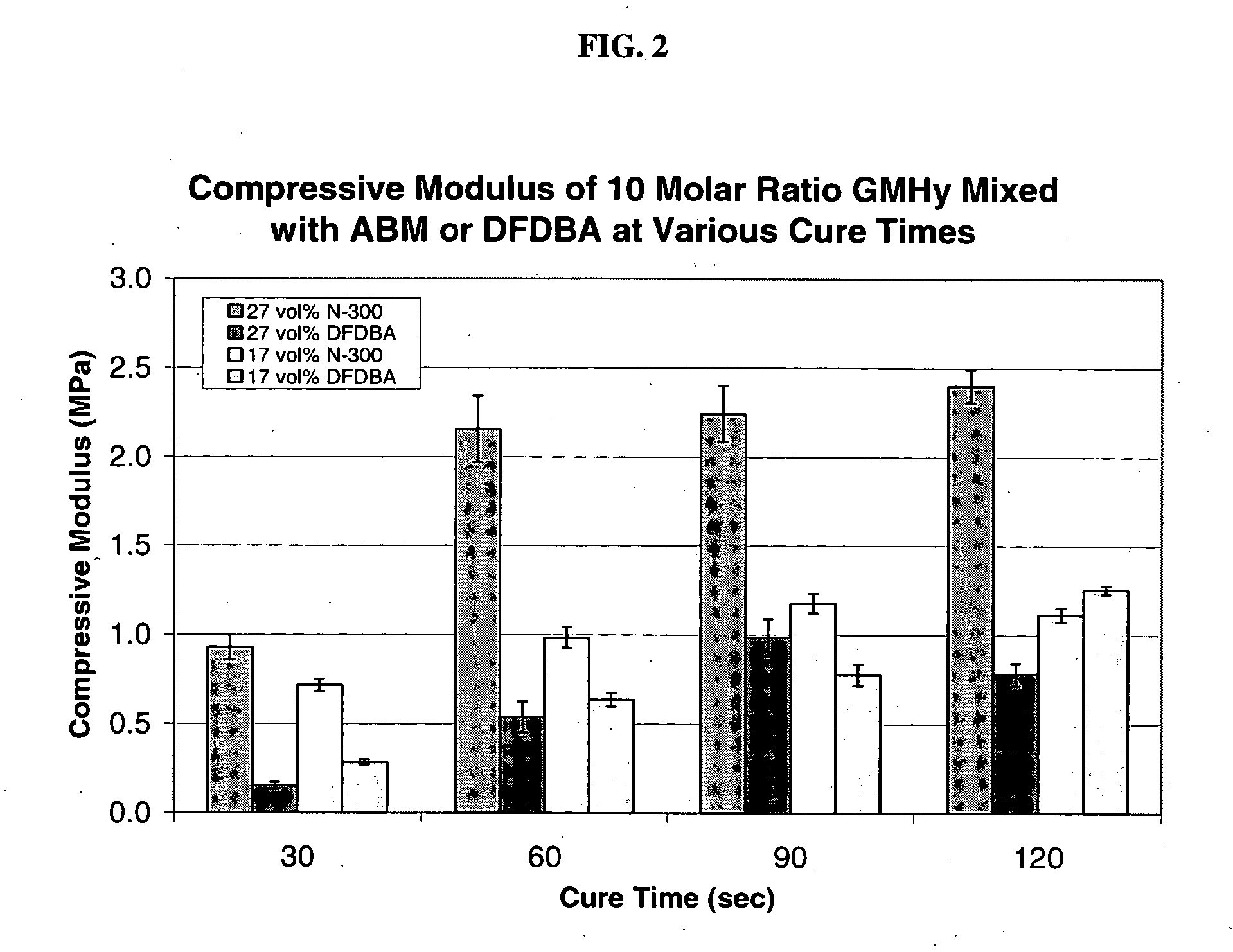Light-curable bone growth material for treating dental bone defects
a bone growth material and light-curable technology, applied in the direction of impression caps, prostheses, drug compositions, etc., can solve the problems of lower mechanical strength post-cure, and achieve good viscosity and handling properties, good dimensional stability
- Summary
- Abstract
- Description
- Claims
- Application Information
AI Technical Summary
Benefits of technology
Problems solved by technology
Method used
Image
Examples
example 1
[0039] Three different methods, as described below, were used to synthesize photopolymerizable sodium hyaluronate (Hy). The methods are referred to as Reactions I, II, and III.
Reaction I. GMHy (methacrylated Hy) Synthesis
[0040] The method described in Leach, J. B., et al., Photocrosslinked Hyaluronic Acid Hydrogels: Natural, Biodegradable Tissue Engineering Scaffolds, Biotechnol Bioeng, 2003. 82(5): p. 578-89 was generally followed (hereinafter referred to as the “Leach Method”) to prepare a GMHy carrier.
[0041] 1% Hy was reacted with a 10-fold molar excess of glycidyl methacrylate and equal amounts of triethylamine and tetrabutyl ammonium bromide in water for 24 hours at room temperature. The reaction was continued at 60° C. for 1 hour. Then, the solution was precipitated in acetone, dissolved in distilled (DI) water, precipitated a second time in acetone, and dissolved again in DI water to remove excess reactants. The GMHy solution was lyophilized and stored.
Reaction II. Hy-M...
example 2
[0048] In the following Example, derivatization reactions were performed under various conditions to determine the effects of reactant concentration, composition, and pH on the derivatization of sodium hyaluronate (Hy) with glycidyl methacrylate. Hy is pH sensitive and the reaction conditions in the Leach Method are basic (pH 10.5-11), due to the addition of a phase transfer catalyst (tetrabutylammonium bromide) and a base (triethylamine). Because of concerns about Hy breaking down in these basic conditions, reactions were done with only glycidyl methacrylate and the phase transfer catalyst at a pH of 8.5, as well as with only glycidyl methacrylate at a pH of 7.2. Additionally, the effects of reactant concentration were investigated by conducting reactions with a glycidyl methacrylate molar ratio of 10, 15, and 20.
[0049] Table 1 shows the amounts of reactants used in each reaction, as well as the pH of the reaction. For Reactions IV and V, 1 g Hy was dissolved at 1% in either 12.5 ...
example 3
[0054] In the following Example, derivatization reactions were performed under various conditions to determine the effects of increasing the reaction times (48 hours) and / or increasing the amount of glycidyl methacrylate added to the solution.
Reaction XIII. GMHy (methacrylated Hy) Synthesis
[0055] The Leach Method was generally followed to prepare GMHy carrier.
[0056] 1% Hy was reacted with a 10-fold molar excess of glycidyl methacrylate and equal amounts of triethylamine and tetrabutyl ammonium bromide in water for 48 hours at room temperature. The reaction was continued at 60° C. for 1 hour. After the reaction, the solution was precipitated in acetone, dissolved in DI water precipitated a second time in acetone, and dissolved again in DI water to remove excess reactants. The GMHy solution was lyophilized and stored.
Reaction XIV. GMHy (methacrylated Hy) Synthesis
[0057] The Leach Method was generally followed to prepare GMHy carrier
[0058] 1% Hy was reacted with a 15-fold molar ...
PUM
| Property | Measurement | Unit |
|---|---|---|
| particle size | aaaaa | aaaaa |
| particle size | aaaaa | aaaaa |
| density | aaaaa | aaaaa |
Abstract
Description
Claims
Application Information
 Login to View More
Login to View More - R&D
- Intellectual Property
- Life Sciences
- Materials
- Tech Scout
- Unparalleled Data Quality
- Higher Quality Content
- 60% Fewer Hallucinations
Browse by: Latest US Patents, China's latest patents, Technical Efficacy Thesaurus, Application Domain, Technology Topic, Popular Technical Reports.
© 2025 PatSnap. All rights reserved.Legal|Privacy policy|Modern Slavery Act Transparency Statement|Sitemap|About US| Contact US: help@patsnap.com



